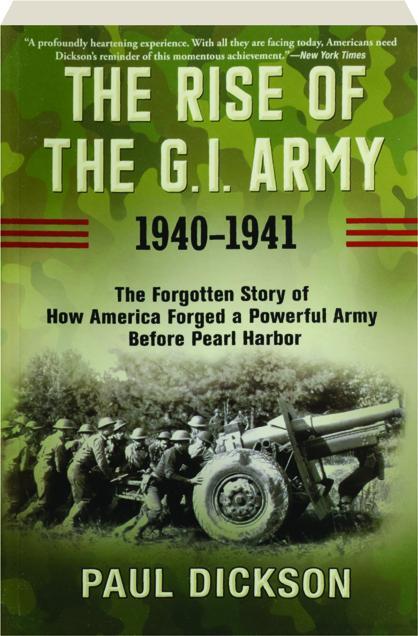 I have a fascination with the U.S. Army between WW1 and WW2. I return to Brian McAllister Linn’s Guardians of Empire periodically. One of my favorite histories of the U.S. Army in WW2 is Geoffrey Perret’s There’s a War to be Won. That book covers the interwar period and development of things like the 105 mm howitzer, M-1 rifle, the Jeep, the triangular division etc.
I have a fascination with the U.S. Army between WW1 and WW2. I return to Brian McAllister Linn’s Guardians of Empire periodically. One of my favorite histories of the U.S. Army in WW2 is Geoffrey Perret’s There’s a War to be Won. That book covers the interwar period and development of things like the 105 mm howitzer, M-1 rifle, the Jeep, the triangular division etc.
I spotted Paul Dickson’s The Rise of the G.I. Army 1940-1941 at the library last week and decided to read it. The book starts with Gen. George C. Marshall taking over as chief of staff of the U.S. Army in 1939 and his cajoling of President Franklin D. Roosevelt to increase military spending and the size of the army.
Whereas Perret’s There’s a War to be Won goes into the nuts and bolts of military development and procurement, The Rise of the G.I. spends a lot of space on the political maneuverings of FDR with Congress and an American public who was non-interventionist.
Something I have noted with many a WW2 history. More than one author will bemoan the perilous state of the U.S. Army in the 1930s. The 1920 National Defense Act authorized the Army at 280,000 enlisted men and 17,043 officers. The U.S. Army was 135,015 in 1933. Who cut the Army budget by 33% in 1933? Who signed the Neutrality Act of 1935 into law? There is a cognitive dissonance with FDR lauded as the great war president who also strangled the military for six years. Dickson mentions that George C. Marshall stated in an interview in the late 1950s that the war would have been shorter and with fewer casualties had there been a full expansion 1938-1939.
The mood of the American public against involvement in a war in Europe is given quite a bit of space. I read once, I forget where, that the West and South had no such misgivings about a war with Japan. This is never mentioned in this book.
Dickson devotes time to the importance of the CCC camps. Roosevelt tapped Chief of Staff Douglas MacArthur to have the Army run the CCC camps. These were important as you had young men in a disciplined environment, given medical and dental care, taught vocational skills. It was good training for future army leaders on mass mobilization of men. Many CCC graduates would become NCOs a few years later.
Weapons procurement is not mentioned that much. The M-1 rifle is mentioned briefly. The mechanics of the Selective Service System is examined in detail. I did not realize that draftees were to serve only for one year and then discharged for an ever growing reserve. The Army was up to 1.6 million on December 7, 1941. The term of service was extended by a vote in Congress that won by one vote in autumn 1941. Marshall was creating a force ready for war.
The book spends a lot of time on the army maneuvers of 1940 and 1941 including the famous Louisiana maneuvers. He goes into quite a bit of detail where Patton, Eisenhower, Clark and others made a name for themselves. Marshall also purged the Army of thousands of incompetent officers who performed poorly.
No space is given to the garrisons in Hawaii, Panama, Puerto Rico, and the Philippines. Dickson also does not go into how Roosevelt’s extension of Lend Lease to Hitler’s former ally, Stalin’s Soviet Union deprived equipment for the U.S. Army when George C. Marshall was attempting to create a modern army that could go toe to toe with the Wehrmacht.
One interesting thing in this book. There is a picture of a parachute drop in August 1941 maneuvers. The paratrooper is wearing a brand new M-1 helmet that had just been adopted just a couple months earlier. The earliest picture I have seen of the M-1 helmet was from April 1942 of Gen. Stilwell and some of his staff in Burma.
There are a few mistakes I noted. He refers to the Pennsylvania National Guard as the 26th Division. It is the 28th Division (aka the Keystone Division, and the “Bloody Bucket”). A picture has the caption of men of the 13th Division. There was no 13th Division, it was probably the 13th Regiment.
Dickson goes back again and again the the military was segregated. The Republican presidential candidate for 1940, Wendell Wilkie was actually for desegregation of the military. It was Roosevelt who backed off integration. For more detail, you can check out The Employment of Negro Troops. An integrated army would have been of benefit when the Army was desperate for infantry replacements during and after the Battle of the Bulge. The pool of infantry replacements would have increased by 10% at the minimum.
I would recommend a reader search out Geoffrey Perret’s There’s a War to be Won first. Dickson’s The Rise of the G.I. Army makes for a nice pendant with its emphasis on Congress, legislation, and the big maneuvers.
Dickson’s central point is the U.S. Army was not forged after Pearl Harbor but before.
Please give us your valuable comment